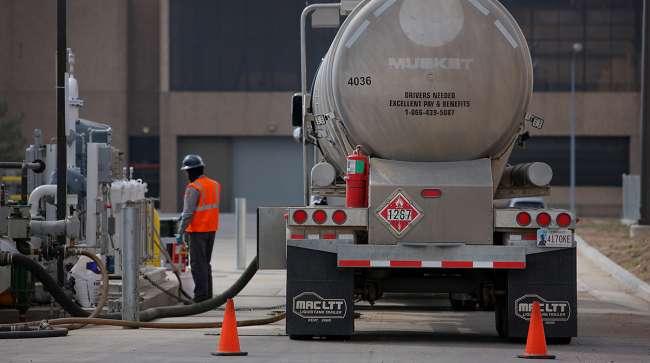Senior Reporter
Diesel Rises 0.7¢ to $2.472; Crude Prices Settle at About $45

The U.S. average retail price of diesel rose 0.7 cent to $2.472 as U.S. oil drilling declined and crude prices rebounded to clear $47 a barrel before retreating to about $45, experts said.
It was diesel’s first increase after four consecutive weekly declines.
Diesel now costs 4.9 cents more than it did a year ago, when the price was $2.423 a gallon, the Department of Energy said July 3.
Regional prices for trucking’s main fuel rose everywhere, except in the Rocky Mountain area, where the price dipped 0.7 cent.
The U.S. average price for regular gasoline fell 2.8 cents to $2.260 a gallon. The cost is 3.1 cents more than it was a year ago, DOE’s Energy Information Administration said.
Weekly gasoline prices also fell in all regions, EIA said. The average price for gasoline has dropped 15.4 cents a gallon since June 5.
Demand for both diesel and natural gas is on the rise, EIA said.
For the week ending June 30, distillate fuel product, which includes ultra-low-sulfur diesel supplied, was 4.3 million barrels per day, up 293,000 from a week earlier, EIA said.
Estimated consumption of natural gas as a vehicle fuel also was up 8% through the first four months of this year, compared with the same period in 2016, EIA said in its latest Natural Gas Monthly report. Usage in vehicles in the 2017 period climbed to 14 billion cubic feet compared with 13 billion a year earlier, EIA said.
Meanwhile, July 5 prices for natural gas were below diesel prices at the 18 Love’s Travel Stops that have fast-fill pumps for Class 8 trucks and ranged from a low of $1.79 to a high of $2.29, according to the company website.
In related news, Kenworth Truck Co. said its T680 on-highway flagship tractor and T880 and T880S vocational “leaders” are now available for order with the Cummins Westport ISL G Near Zero NOx (nitrogen oxide) emissions natural gas engine.
Exhaust emissions of the ISL G Near Zero are 90% lower than the current Environmental Protection Agency and California Air Resources Board NOx limit of 0.2 gram per brake horsepower hour, and they meet the 2017 EPA greenhouse gas emission requirements, according to Cummins Westport.
The engine is ideal for regional-haul, vocational and refuse fleets, Kenworth said.
However, regional tensions in the Middle East and a decline in hydraulic fracturing oil production in the United States are factors likely to lift prices for oil and thus take diesel higher this year, one expert predicted.
“There is not going to be as much new oil produced,” energy economist Charles Olson, a professor at the University of Maryland-Robert H. Smith School of Business, told Transport Topics.
Olson questioned the profitability of hydraulic fracturing conducted by “scrappy” companies, their production levels going forward and “the willingness of the bankers to keep financing this stuff. They keep producing, but they don’t have any cash flow. I think there will be less of it.
“I see oil above $55 in a year. If it hits $70 a barrel, that wouldn’t surprise me,” Olson said. “It could move really fast.”
Oil previously was near $55 a barrel on April 17, 2015, when diesel cost $2.754 a gallon on April 13.
West Texas Intermediate crude futures on the New York Mercantile Exchange closed at $45.13 per barrel July 5, compared with $44.74 on June 28.
“A surprise fall in U.S. production in April and oil rigs [the week ending June 30] may ease concerns that U.S. crude production is ramping up too aggressively,” Giovanni Staunovo, an analyst at UBS Group AG, wrote in a research note, according to Bloomberg News. “OPEC compliance and lower U.S. oil inventories could prompt higher oil prices in the coming weeks.”
EIA reported U.S. crude production fell in April by 24,000 barrels per day to 9.08 million bpd, compared with March. “This is the first drop in the monthly production since last November,” said Stephen Sly, president of Stabilitas Energy Inc., a risk management firm.
The weekly U.S. rig count also fell to 940 during the week of June 30, one rig less than the week before and 509 more than a year earlier, oil field services company Baker Hughes Inc. reported.
That decline followed 23 straight weeks of rig increases, the longest stretch in three decades, Bloomberg said.
Houston-based Baker Hughes ranks No. 14 on the Transport Topics Top 100 list of the largest private carriers in North America.




